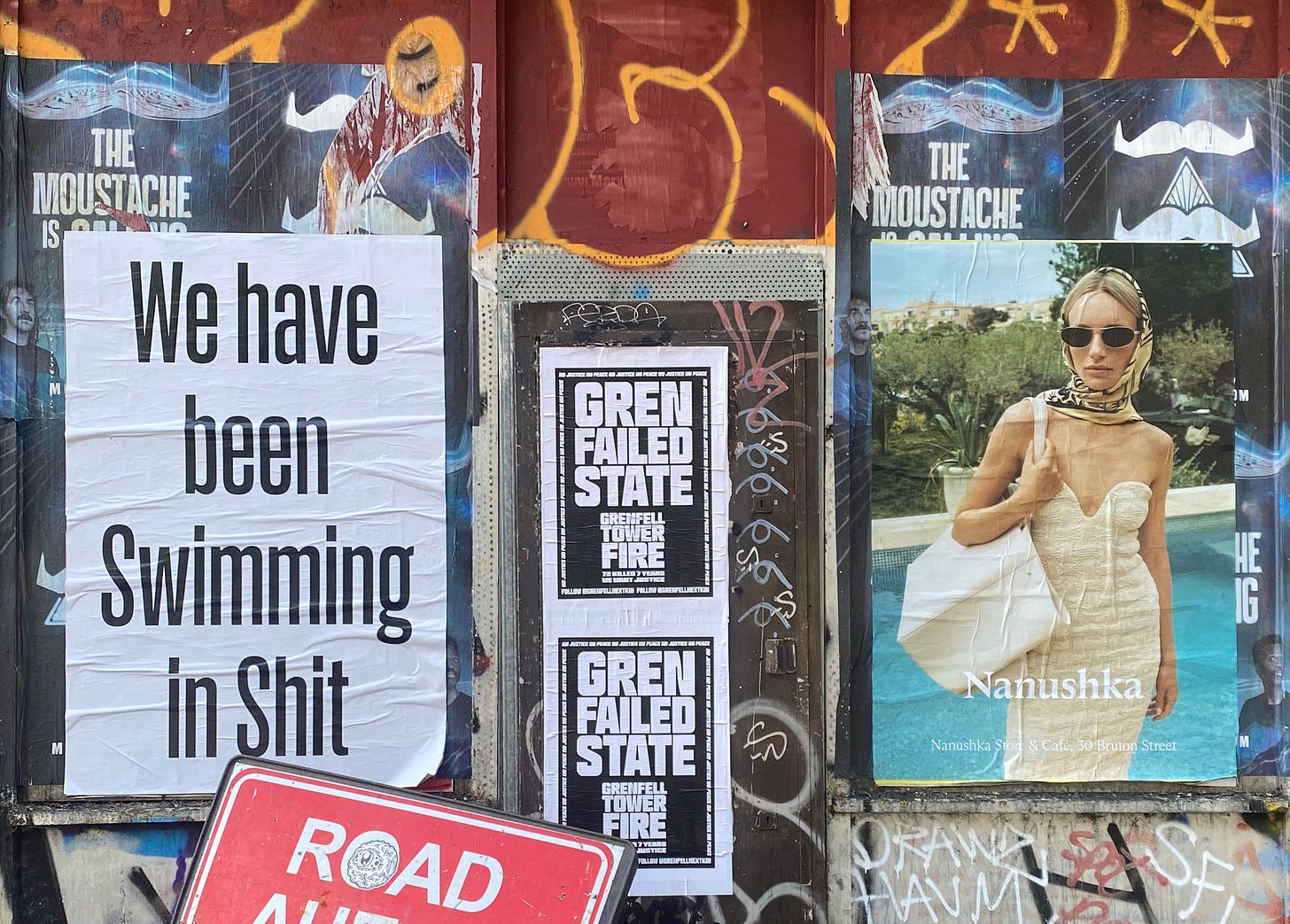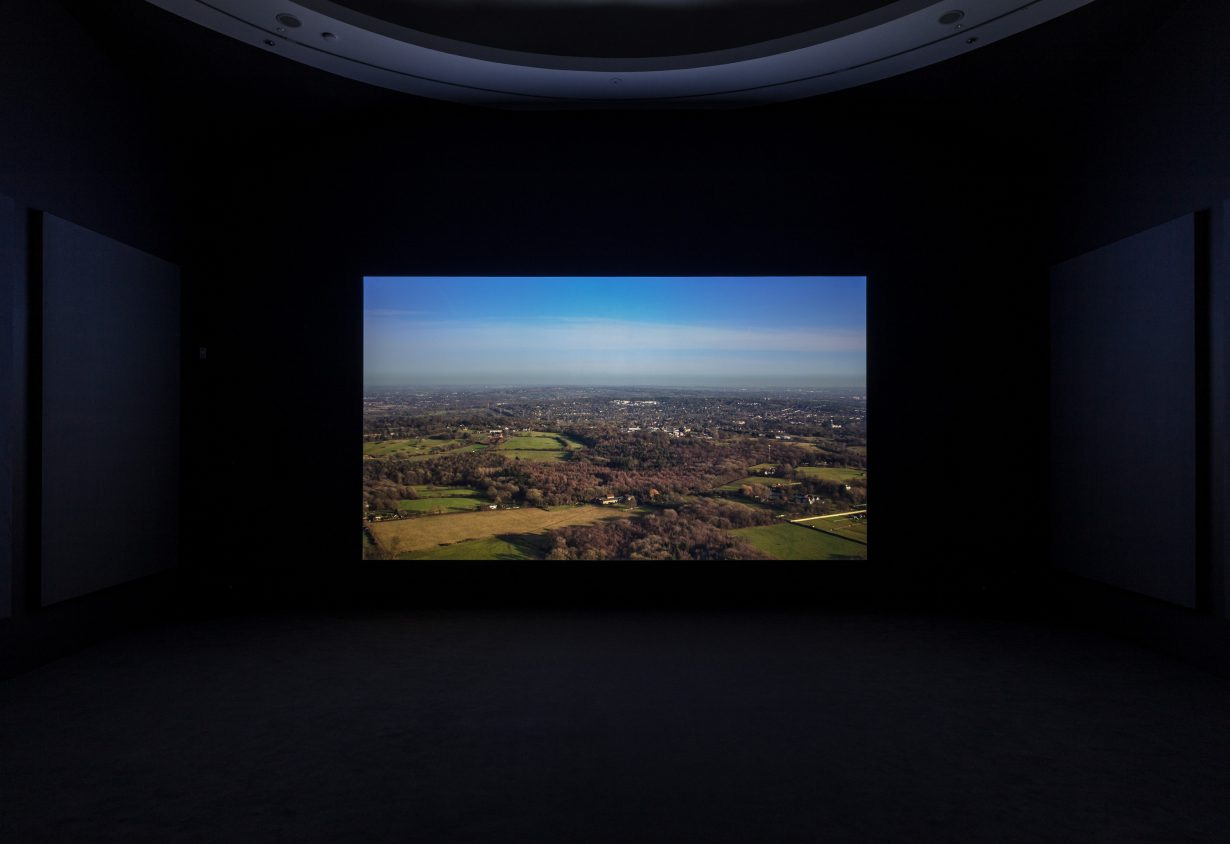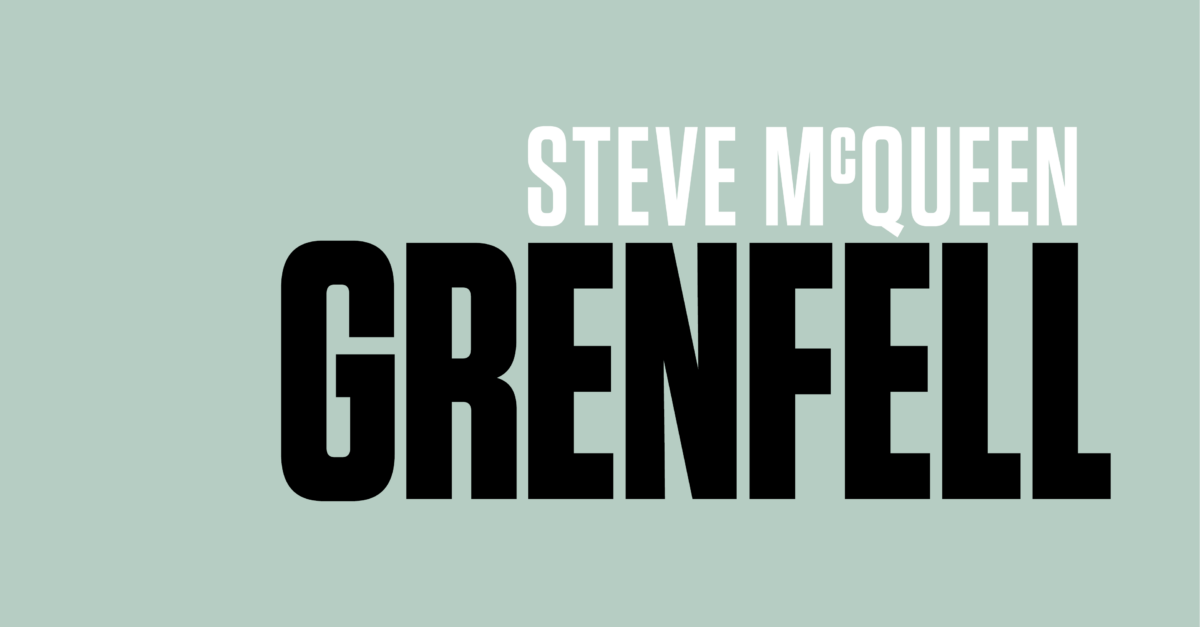Walking down Westbourne Park Road, a pale green heart pops above the townhouse rooftops. A pang hits me, a feeling of surprise. It’s so close. That I would see it so soon. And yet, that from here, it’s so small. Crossing Ladbroke Grove, as I walk it’s eaten up by the houses, the buildings between us.

A week under seven years before, I saw the smoke plume rising across the horizon as I stepped off the train to work. A black-grey smudge behind the skyline, drifting north with the wind. An inferno, that had raged for a night.
We’d woken up to the videos playing back on repeat, across every channel and social feed. An incomprehensible vision of concrete enveloped with flame, engulfed on all sides as its cladding burned like petrol doused kindling, carrying the flames ever on. Even late that next evening I don’t think the fire was out. A smouldering baked black husk refusing to give itself up.
72. Seventy two. The numbers don’t really give it justice. Give them justice.
My girlfriend had grown up West, Queens Park and Willesden. It was her side of town. She knew the building. Part of the landscape of her youth. That day and the next she went, to see, to try and help, to volunteer and sort the donations for the survivors. Maybe to try and make sense of it all.
Walking up St Marks, a jolt, as ‘FOREVER IN OUR HEARTS’ bursts into view around a corner, a break in the estate around me, as an alleyway and nearby small square opens out into space, revealing new sight-lines and views.
This is the first time I’ve been this far West in years. Staying here for a night, it felt right to make this journey, but I can’t make it make sense to me. Not really.
Now it’s wrapped in plastic, sheeting strung between an exoskeleton of scaffolding covers the site from sight. It’s a shroud, an industrial shroud. At the top, the green heart, an emoji of collective grief and guilt, saying everything and nothing, because how can one put a thing like that into words?
As I get closer I feel a pain in my chest, a familiar, tightening grip.
*
April 26th, a year earlier, I’d walked up through Hyde Park from Knightsbridge, crossing the dirt parade route for the upcoming coronation, slowly making my way through this unfamiliar pocket of greenery towards the Serpentine Gallery. I had come by myself, with a ticket to see the first screening that morning of artist/film director Steve McQueen’s film. Captured in the days before the cover was erected, the film documents the building after the fire in a single twenty two minute long shot.
We sat alone on a small bank of seating in the intimate muted dark of the screening room, side by side with strangers, those who had similarly come to see, to try to understand, to try to pay some form of respect, to recognise loss and grief and the shock and trauma, to make space for it and to be present to it, in some small way, even if only in our hearts, in the face of the brute insignificance of ourselves. Perhaps simply just to see.
The film begins far to the West and North. It doesn’t feel like London at all. Fields and open green spaces give the sense of a rural idyll. There are roads, the odd box store, smatterings of housing and suburbanite closes. The noise is what hits you first, the drone, reverberating cyclically with rotor blades compressing air, that tell of a helicopter that we know from the movies. We can’t see it, the airborne vehicle that carries the camera, there is just the sound. All framing of the shot, of the eye’s gaze that McQueen presents to us, is invisible.
This gaze travels forward. There are no landmarks, it’s hard to know what you’re looking at. One searches for recognisable features, a park, a church spire, a road, train tracks. It starts high, slowly decreasing in altitude. There are occasional turns, as the helicopter switches direction. The camera fixed it seems, front-on. The flight plan jagging at once point right, at another left, each twist ripping the ground away from the image, pulling all centre from it in disorientation. There is something bug-like in this trajectory, the insectoid jags of a fly, carrion fly perhaps, Calliphoridae, each turn over-determined, pulled by some occult logic, snapping to trail the scent of death and ash.
Slowly descending towards the city, ambient noises rise in the mix, traffic, the odd car horn. As we fly the helicopter noise that seemed innocuous at first, one of the few points of identification before fading from focus, becomes increasingly ominous in its constant presence, a driving buzzing machinic noise that elevates the unsettling nature of the decentred view before us. All this is background, preface, exposition, awaiting its subject and what we know is to come with apprehension and a rising disquiet.
It’s almost a surprise when you do see it. A small grey smudge in the unfolding concrete textures of the city. Insignificant. Indistinguishable from the rest. Coming in from the North, passing over the hatch mark x’s of St Mary’s Cemetery, the eye grasps Westway bisecting the image, a kind of frontier or event horizon. Suddenly, as the shell rises into view, into focus, arresting all else, the screeching howl of a passing tube train climaxes and the film drops into silence.
The unnameable. Twisted metal, burnt scorched cladding, blistered and bubbled like metastasised earth, beyond nature, this post inferno, this wasteland.
The shell - it’s no longer a building - is mute. The silence is befitting, it elevates the incomprehensibility of it all, here is a truth, the veneer of the world, of the country stripped back, burnt away. Here is the truth beneath, brute material, unfeeling dead carcass.
The eye is unflinching, but it doesn’t, perhaps can’t, show us anything. The object is cold, twisted, unfathomable, all referents removed, a purely abstract site of absence, an abscess.
There is poignancy in the approach, the juxtaposition; the tower blocks nearby, nearly identical, human, homes, lives; the school, brightly clad in its own mosaic of greens and silvery blues, overshadowed by the horror looming above.
This mausoleum, its shade echoing a blackened Tardis - bigger on the inside, yes, depths receding into the infinite voids of seventy two lives, and all their promise and hope and love and faith extinguished, nay consumed in flame.
The sound returns, these screeching brakes of metal on metal, the unthinkable/unnameable bobbing/hovering gently on the currents of the ‘copter, locking us in our gaze.
These notes, made typing into my phone, staggered against the gardens about the Serpentine in the fierce sunlight of a summer’s day, are the immediate unfiltered impressions of watching McQueen’s film that morning. Even reading them back I feel a nausea.
From the moment Grenfell Tower comes to the fore it remains. The helicopter moves about it, spinning spirals about the void of an empty room, in a ceaseless arc negotiating the air, the environment around the husk. The camera circles, mapping its features, the rivets and hollows, glimpsing inwards, towards the impossible insides. Our gaze skirts at the edge of this event horizon, no life escapes from the gravity well here, no ghosts haunt these halls, there is no anchor left behind to the lives lost.
Silent for the most part, watching the film was accompanied by the sounds of its audience. The dozen or so who watched it together at that time. The gentle rustle of clothing as someone wriggled slightly, shifting to find a more comfortable balance of weight on the rigid seating. A young family sat on the carpeted floor to one side with their gurgling baby. Or perhaps most poignantly, the laboured breathing of the old man sat next to me, his wheezing trachea and rattled lungs echoing respirators in deep smoke or an asthmatic grasping for air. Against the silence of the image, in the quietude of the gallery, these sounds held us at a distance. Perhaps grounding us in our communal experience. We, the living.
In Pasolini’s final film, Salò, or the 120 Days of Sodom, after leading us through the circles of Inferno reenacting de Sade’s permutations of depravity to the depths of the pit, to the end point of fascist-capitalist exploitation, violence, sadism and murder, to the point of absolute evil, the devil itself, to the edge of soul shattering corruption, right at the last moment, just as Dante does before him in the Divine Comedy, Pasolini turns us away. Having shown us this logic and taken us to the threshold of its consummation, he returns us to the spectacle, to the dream, and pulls us into a hollow facsimile of song and dance.
McQueen doesn’t look away. Right to the end, his gaze is unflinching, fixed on. Passing and circling, giving the ruin space to speak to us, as if waiting for a tone to arise out of its depths. The camera zooms in, almost filling the frame, taking us in close, as if wanting to touch, to enter, to peer around corners and step into the barren concrete. It’s vertiginous. These extreme close ups juxtapose with the ‘real world’ behind, dizzying passes of distant suburban backgrounds blur through the edges of the frame. All we have to hold on to is the hulk in the eye of this storm, as the ‘real’ whirls about us like some pastiche corona of light and life. In the untouched base on one side of the tower, an echo of normality clings to this rock, a patina of the before.
The film ends with a shriek, metal on metal, sound returning to the room with the hellish brakes of a tube train at the nearby station calling us back to the world as the blackened husk immobile, stares us down.
*
I remember the first time seeing the tower after the fire. The bleak, awed horror driving past along the Westway. It made the bottom fall out of your stomach. A fleeting glimpse, reflection in a rear view mirror, a peeked glance over the shoulder between lane changes and exit ramps. Each time, the same.
McQueen offers us the chance to bear witness. To not look away. To not hide beneath a shell of hoardings, or cower behind a carapace shroud to ease the forgetting and let it pass from our minds, the absence irrupting here invisible to the eye. It is the chance to be present, to live with it through the long unbreaking gaze, to face up to the truth that Grenfell speaks to us in its silence. The bitter truth that name marks for us, the inequality, the corruption, the criminal ineptitude and negligence, the racism, the pathological need to profit, the exploitation, the lies, the deceit, that this reflects who we are. The country, our unnameable nexus, convergence of all the fell lines of centuries. That, are we not all responsible - for allowing this to have happened, for it still to be possible now, seven years later.
I can only imagine the anguish and grief of the survivors, the bereaved, locals, rescue services, all who lived through the event. Sorrow rises, tears well in my eye, to think of them, of their viewing this film, of the trauma re-opened, as if it could ever have shut. I think of proximity and distance, how as close as we may come to this, as close as McQueen’s encircling gaze may take us, Grenfell and all of the life that it once held is forever out of our reach.
Upon exiting the screening, on a wall to the right, the names of the seventy two victims of the fire were printed. I stood there, reading each name quietly to myself, unthinking, enunciating their vowels ad vitam aeternam.
*
As I turn the corner by the leisure centre and across from the school, the sound hits me. A refrigerated truck, its fans impossibly loud, straining at the edge of themselves, a whirling droning ache of a sound that deafens the mind. A profound nausea hits me. The title of a Manics song runs through my head, The Intense Humming of Evil, as if escalating to some apocalyptic crescendo as I near. Passing the truck, dazed at the noise, I am suddenly at the base. The shrouded tower looms above, dominating the sky. I can barely look up at it, what is there to see, beyond the tarp is only grief, and I bury my head in shame. I walk along the fence reading the messages and tributes, the names of the victims. Tears well up in my eyes, as above the expressions of loss and grief and sorrow, crudely scrawled in sharpie, “where the ladders don’t reach”, hits like a punch in the guts. Walking away, the humming, fading slowly, seems to follow me down the street. My chest is tight and I feel short of breath, shaken by it. The mundane returns, a radio playing, scaffolders dismantle their work, drowning out the hum. Nausea and a lingering disquiet remain. And even in the warm sun of a glorious summer’s morning, a chill clings to me.



